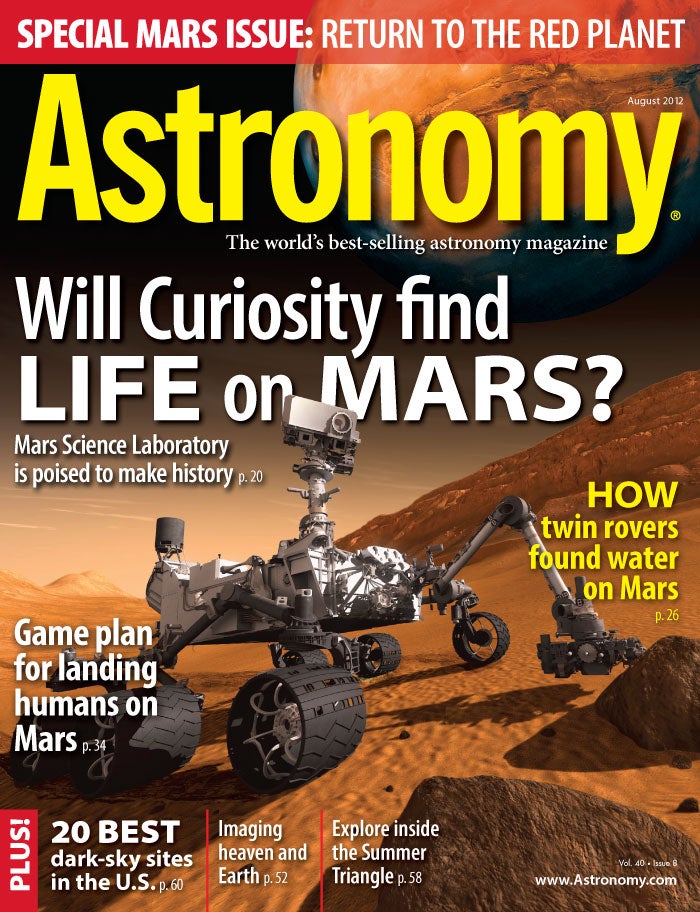
WAUKESHA, Wis. — August 6, 2012, is a date planetary scientists have been waiting a long time for — more than eight years, in fact. In April 2004, NASA invited proposals for instrumentation for its next-generation rover, the Mars Science Laboratory, scheduled to launch in 2009. The agency accepted tools that would make the newest member of the Mars Exploration family a robot astrobiologist, and it earned the nickname Curiosity. But due to budget issues and testing and hardware challenges, NASA was forced to postpone the launch in late 2008. Finally, on November 26, 2011, Curiosity lifted off from Cape Canaveral in Florida on its eight-month journey to the Red Planet.
Astronomy celebrates the mission and scientists’ exploration of Mars in this special issue. The magazine details Curiosity’s science goals and how it will accomplish them, looks back on the success of NASA’s last two rovers (including one that is still functioning), explores the plan for a possible future manned mission to the Red Planet, and delves into astronomers’ fascination with this world since ancient times. The August issue hits newsstands July 3.
“Will Curiosity find life on Mars?”
The Mars Science Laboratory is the largest, most adept, and most expensive mission to explore Mars, so expectations for the rover are high. As a robot astrobiologist, Curiosity will investigate the planet as a potential habitat for life, past or present. In “Will Curiosity find life on Mars?” author Jim Bell — a member of the Mars Science Laboratory mission team — provides an overview of the rover’s dozen science instruments, how each works and its main purpose; explains the reasoning behind NASA’s selected landing site, Gale Crater; and details the complex series of maneuvers that will deliver Curiosity to the martian surface. “It is anyone’s guess what Curiosity’s remote-controlled senses will reveal,” writes Bell. “All we really know is that scientists never will be able to answer the question ‘Are we alone?’ unless they make the effort to search beyond the confines of our home planet, … and robots like Curiosity provide a cost-effective way to begin.”
“How twin rovers found water on Mars”
Planetary scientists might be looking forward to Curiosity, but they haven’t forgotten about the two amazingly successful precursors to the mission — the twin Mars Exploration Rovers. When Spirit and Opportunity landed on the Red Planet in January 2004, scientists hoped to get 90 days of work out of them. Instead, Spirit lasted until March 2010, and Opportunity is still rolling along. In “How twin rovers found water on Mars,” author Robert Burnham details the trials and tribulations of these two robot geologists, including many lines of evidence they found that water once existed on the Red Planet.
“Illustrated: How we’ll get to Mars”
Although no manned mission to Mars exists in NASA’s near-term plans, the space agency’s administrator has directed the Science Mission Directorate to lead a reformulation of the Mars Exploration Program that addresses the president’s challenge to send humans to orbit our neighboring world in the 2030s. But what about landing and exploring the Red Planet? In “Illustrated: How we’ll get to Mars,” Senior Editor Richard Talcott and Illustrator Roen Kelly explore NASA’s most recent outline of such a mission, which involves a six-month journey to the planet, 1.5 years of exploration, and another six-month trip back to Earth.
August sky events visible without optical aid
- August 11/12 — The Perseid meteor shower peaks
- August 15 — The eastern pre-dawn sky hosts a parade of planets — Mercury, Venus, and
- Jupiter — and a thin crescent Moon.
- August 21 — Saturn, Mars, a crescent Moon, and the bright star Spica put on a display in
- the constellation Virgo after sunset
Also in the August 2012 Astronomy
- “The Red Planet’s colorful past” — Since antiquity, Mars has captured our minds and imaginations, and its study has led to some important discoveries — and some of the greatest misconceptions — in planetary science.
- “Imaging heaven and Earth” — Astrophotographer Wally Pacholka has made an art of capturing amazing landscapes and skies.
- “Explore the Summer Triangle” — Although you’ll never see Mars within the area bounded by these three bright stars, you can explore double stars, nebulae, and star clusters.
- “20 best dark-sky sites in the U.S.” — Searching for a place to set up your telescope? A top-notch location might be closer than you think.
- “Astronomy tests Vixen’s compact astroimaging mount” — The Polarie Star Tracker makes it easy to take long-exposure wide-field images.
- “The Sky this Month” — Exclusive star charts will guide you through August’s night sky.
- The August issue of Astronomy also includes Astro News, Bob Berman’s Strange Universe, Glenn Chaple’s Observing Basics, Stephen James O’Meara’s Secret Sky, Tony Hallas’ Imaging the Cosmos, Ask Astro, Letters, Web Talk, Deep-sky Showcase, New Products, Reader Gallery, and The Cosmic Grid.









